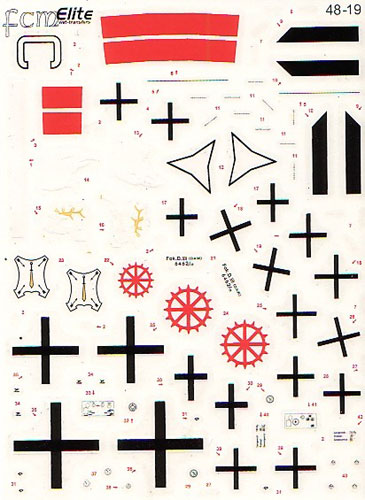|
S u m m a r y
|
| Catalogue
Number: |
Elite wet transfers #4819
Fokker D.VII |
| Scale: |
1/48 scale |
| Contents and Media: |
One wet transfer sheet and
instructions |
| Price: |
Around USD$10.00 from model
retailers worldwide |
| Review Type: |
Preview |
| Advantages: |
No resultant carrier film, well
researched subject choices, “bonus” decal items. |
| Disadvantages: |
|
| Recommendation: |
Highly Recommended |
Reviewed by Rob Baumgartner

vailable online from Squadron.com
It is pleasing that this manufacturer has stuck with
the “wet transfer” idea as this has proven to give excellent results. The
idea is that the modeler applies the “decal” in the usual way and when
dry, peels off the thick protective film. Those that shuddered when seeing
what appears to be a product with very thick carrier film need not worry.
 The
result is an image that looks painted on with the complete absence of any
carrier film. For those not used to this idea, FCM supply five spare
images for you to practice with! The
result is an image that looks painted on with the complete absence of any
carrier film. For those not used to this idea, FCM supply five spare
images for you to practice with!
The sheet provides six options catering for variants from two of the three
manufacturers for this aircraft.
The stated references used are the Albatros Publications series on the
D.VII so there can be no complaints about the source material.
The instruction sheet suggests using the Revell, Dragon or Roden kits. As
they are all slightly different in dimensions, careful testing with the
option you choose is necessary before final application.
A check of the fuselage motifs suggests that they will fit correctly on
the Roden fuselage. As for the crosses, the underside ones fit perfectly
on this kit but those on the top wing are a little short. Naturally the
appropriate kit items can be used instead.
Other pieces found on the sheet include Axial prop logos, various
instrument faces; both Albatros and Fokker style instrument panels and
stencil data.
The instructions mention “wingspan application”. Note that this refers to
the whole wing being covered in lozenge, not the method of application.
 1.
Fokker D.VII (Albatros built), Oblt. Robert von Greim, Jasta 34b 1.
Fokker D.VII (Albatros built), Oblt. Robert von Greim, Jasta 34b
Although stated in the instructions as white, there
should be an element of silver in the staffel colour that is applied to
the rear fuselage.
Robert von Greim scored at least 25 victories and
survived to lead Fliegerkorps V during WWII. He later committed suicide.
2. Fokker D.VII (OAW built), Ltn. Ernst Riedel, Jasta 19
Riedel joined Jasta 19 in May 1918 but was unable to
score any victories. He lost his life on 16 August 1918 test flying Fokker
EV 107/18.
3. Fokker D.VII (OAW built), Oblt. Hasso von Wedel, Jasta 24
Modellers should note that this is a BMW powered
machine. The instructions suggest 4-colour lozenge but 5-colour is more
likely.
Wedel became an ace with his five victories and later
went on to fly fighters in WWII. He flew in the Battle of Britain as a
member of the JG3 but was shot down on 15 September 1940 by Pilot Officer
R H Holland of 92 Squadron.
4. Fokker D.VII (Albatros built), Ltn. Frodien, Jasta 40
This is certainly an original choice in this scale.
Not much is known about the man other than he joined Jasta 40 on 15 June
1918. There he remained until the end of the war.
Although the instruction says grey, photos suggest
that the forward fuselage struts were more likely black
.
5. Fokker D.VII (Albatros built), Carl Degelow, Jasta 40
This is a popular subject amongst modelers. It also
is finished in 5-colour lozenge rather than the quoted 4-colour. Note that
this machine may also have had black forward fuselage struts as seen in
photos of other Jasta 40 D.VII aircraft.
Degalow scored 30 victories, the last 26 with this
Jasta. He was also the last airman to receive the Pour le Merite or “Blue
Max”. After serving in the Luftwaffe in WWII, he died in Hamburg on 9
November 1970.
6. Fokker D.VII (OAW built), Ltn.d.R. Arthur Merz, Jasta 28
Merz only scored one victory and that was a Bréguet
on 15 August 1918. He was severely wounded not long after and died on the
27th of that same month.
This aircraft carried a white datum line on the
starboard side, which the builder can easily make from white decal strip.
This is another interesting sheet with a nice variety
of markings. It compliments FCM’s previous release very well and allows
the modeler a wide choose of subjects from the different D.VII
manufacturers.
The method of applying the transfers will be new to most and should not
scare off the builder. The results are worthwhile and FCM should be
commended for going down this path.
Highly Recommended.
Thanks to
Felipe from FCM
for the review sample
Click here
to view a list
of FCM distributors
Preview Text Copyright © 2003 by
Rob Baumgartner
This Page Created on 26 December, 2003
Last updated
26 December, 2003
Back to
HyperScale Main Page |
Home | What's
New | Features
| Gallery |
Reviews | Reference
| Forum
| Search